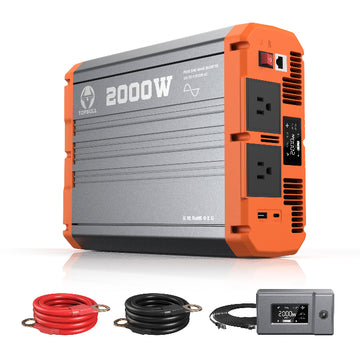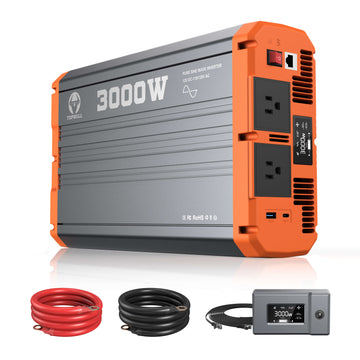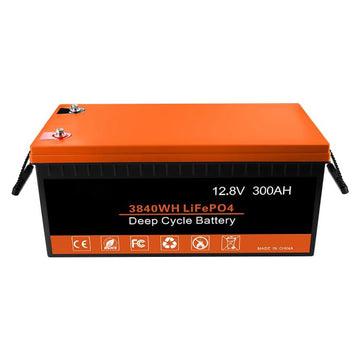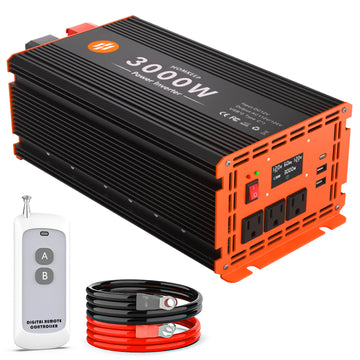What is a 12VDC to 120VAC inverter?
12VDC to 120VAC Inverter is a common device that converts 12V DC power to AC power with a nominal output of 120V. 120 volts AC is the standard household voltage in many countries, including the United States.
This conversion is essential for operating household appliances, electronic equipment, and other devices that require standard AC power. 12V inverters act as a bridge between the battery systems commonly found in vehicles, boats, or solar systems, and the regular power needs of various devices.
How many volts do I need for the inverter?
Input voltage of the inverter
The input voltage is the DC voltage that the inverter receives from an external power source. The external power source can come from a variety of sources, including batteries, solar panels, etc. The inverter must be able to handle these different input voltages. The input voltage is critical because it directly affects the efficiency of the inverter and its ability to convert DC to AC.
- Voltage Range: Each inverter is designed to operate within a specific voltage range. For example, a 12V inverter is designed to work with a DC power supply that provides 12 volts but can tolerate slight variations. This range depends on the design and purpose of the inverter.
- Power compatibility: Common input voltages come from battery banks (12V, 24V, 48V), solar arrays, or other renewable energy sources. 12V inverters are typically used in smaller applications such as vehicles or small off-grid installations. If the input voltage of the inverter does not match the output voltage of the power supply, the inverter may not operate properly or even damage the inverter and other connected equipment.
- Efficiency considerations: The efficiency of an inverter depends on how well the input voltage matches the operating range. For example, if a 12V inverter is connected to a 24V system, the inverter may not operate or performance may be degraded.
Inverter start voltage
The inverter start voltage is the minimum input voltage required for the inverter to start the conversion process. The startup voltage can vary depending on the design and model of the inverter. For 12V inverters, the inverter start voltage is typically between 10V and 12V. This threshold ensures that the inverter can reliably start operation without overloading the connected batteries. For some higher-power inverters, the starting voltage may be higher, for example in the range of 24V or 48V.
- Low voltage protection: Inverters usually have low voltage protection, when the input voltage is lower than the start voltage, the inverter will stop output to prevent damage or unstable operation.
- Start-up procedure: When the input voltage reaches the start-up voltage of the inverter, the inverter will start and begin to convert DC to AC. This process may take some time, especially in low temperatures or other unfavorable conditions.
- Inverter design: The design of an inverter affects its startup voltage and performance. Some inverters may have a wider input voltage range, allowing them to operate at lower voltages.
- Stability: The starting voltage of the inverter is critical to the stability of the system. Ensuring that the inverter can start and operate at the correct voltage range will help prevent system failure and damage.
What is an inverter's output voltage?
The output voltage of an inverter is the voltage produced when the inverter converts DC power to AC power. This AC power is then used to power appliances and electrical equipment. The output voltage varies depending on the geographic area and the type of electrical equipment being powered.
Output voltage types
- Single phase AC voltage: typically provides voltage in the form of a single sine wave. For most residential and light commercial applications, single-phase AC output is the standard.
- Three-phase AC voltage: Three-phase AC voltage refers to a type of AC power supply that is widely used in industrial and commercial power systems to provide power through three AC voltage waveforms. Three-phase inverters provide higher power output and are ideal for heavy-duty applications.
Output voltage standards
The inverter is designed to output 120V or 230V AC depending on the country/region standard. When choosing an inverter, you need to consider the usage scenarios, different countries use different AC voltages, in North America most household appliances use 120V, while 230V is more common in Europe and Asia. If you are not sure what voltage you need, you can use a search engine or check the label on the appliance to see what AC voltage it uses.
Pure vs. Modified Sine Waveforms
The type of waveform an inverter produces affects the quality of the output voltage. Pure sine wave inverters provide a smooth, stable voltage that is ideal for sensitive electronic equipment, while modified sine wave inverters are more cost-effective but may cause problems for some equipment.
Output voltage considerations
- Load requirements: Ensure that the output voltage of the inverter matches the voltage requirements of the connected equipment to avoid damage to the equipment or poor performance.
- Voltage stability: The inverter must provide a stable output voltage to ensure smooth operation of the connected equipment. Voltage instability can result in equipment damage or poor performance.
-
Surge capacity: Some equipment (e.g. motors) may require higher voltages (surge voltages) during start-up. The inverter should be able to handle these short bursts of high voltage to avoid overload or failure.
What is the best voltage for an inverter?
Choosing the best inverter voltage depends on several factors, including the design of the inverter, the power requirements of the connected equipment, and the available power supply. But the dilemma for many is choosing between 12V and 24V inverters.
For an inverter, is 12V or 24V better?
The choice between 12V and 24V inverters depends on the specific requirements of the power system. 12V inverters are suitable for smaller applications such as camping, cars, and boats. While 24V inverters have higher power output and improved efficiency, they are more expensive. 24V inverters are usually preferred for larger systems such as residential and commercial applications.
What is the maximum voltage for an inverter?
The maximum input voltage to the inverter is an important specification to ensure that the equipment operates within safe limits. For 12V inverters, the maximum inverter input voltage is typically about 13.8 V. This safety margin provides a buffer to accommodate power fluctuations and protects the inverter from potential damage.
In practice, the maximum input voltage may vary depending on the specific inverter model and manufacturer. It is recommended that you check the inverter's specification sheet or owner's manual before using the inverter.
What happens if the inverter voltage is too high?
Exceeding the maximum input voltage specified for the drive can cause several problems.
- Inverter damage: Excessive input voltage can cause the drive's internal components to overload or burn out, preventing the drive from operating properly.
- Unstable output: High voltages can cause the AC output from the drive to become unstable, resulting in damage to connected equipment.
- Safety issues: High voltages can pose a fire hazard, especially if there are flammable materials in or around the inverter.
To minimize these risks, manufacturers typically include surge protectors in the inverter. Remember to follow the manufacturer's safety guidelines when using the inverter.
see more: Common Inverter Failures and Their Solutions
How to choose the inverter voltage?
To select the best inverter for your application, it is important to match the inverter's input and output voltage specifications to your power requirements.
Input voltage selection: The DC input voltage of the inverter should match the output voltage of your batteries or solar panels. For example, if you are using a 12V battery bank, select a 12V inverter. Similarly, if you have a 24V or 48V battery system, select an inverter that supports those voltages.
Output voltage compatibility: Select an inverter that provides the output voltage required for your equipment. For residential applications, this is typically 120V AC (for North America) or 230V AC (for Europe and most of Asia).
Power rating: In addition to voltage, consider the amount of power you need. Make sure the inverter you choose has enough power to support the equipment you want to connect.
Consider future needs: If you plan to expand your system or replace your power supply, consider an inverter with a wide voltage range that can accommodate future upgrades.
Waveform type: If you're powering sensitive electronics or medical equipment, choose a pure sine wave inverter that provides a stable, clean output voltage. For less sensitive loads, a modified sine wave inverter may be adequate and less costly.
Inverter recommendations for different voltages
TOPBULL offers a wide range of quality inverters to meet your various power needs. The information below shows that our inverters operate in the optimal voltage range, and are durable and efficient. Equipped with an LCD, you can monitor the operating status of the unit in real time.
If you are looking for inverters for RV, car, home, camping, golf cart, or marine, you can choose from the following products.
FAQ
Q: Why is my inverter output voltage low?
A: Low inverter output voltage can be caused by several things: low batteries, loose connections, internal malfunctions, high ambient temperatures, inverter overload, or inverter aging. Thorough troubleshooting in these areas will help identify and correct the cause of low inverter output voltage.
Q: Can low voltage damage the inverter?
A: Continuous operation of the inverter at low voltage may have a negative effect on the inverter and the load. The inverter may not operate properly or even risk overheating. Keeping the input voltage within the specified range is essential for optimal performance and longevity of the inverter.
Q: Will reducing the inverter output voltage during load shedding help my batteries last longer?
A: Batteries may be damaged after experiencing deep discharges, affecting their lifespan. By reducing the inverter output voltage during load shedding, the deep discharge of the battery can be reduced, helping to prolong the battery's life. However, it should be noted that too low a voltage may also affect the normal operation of the inverter and connected equipment.
















